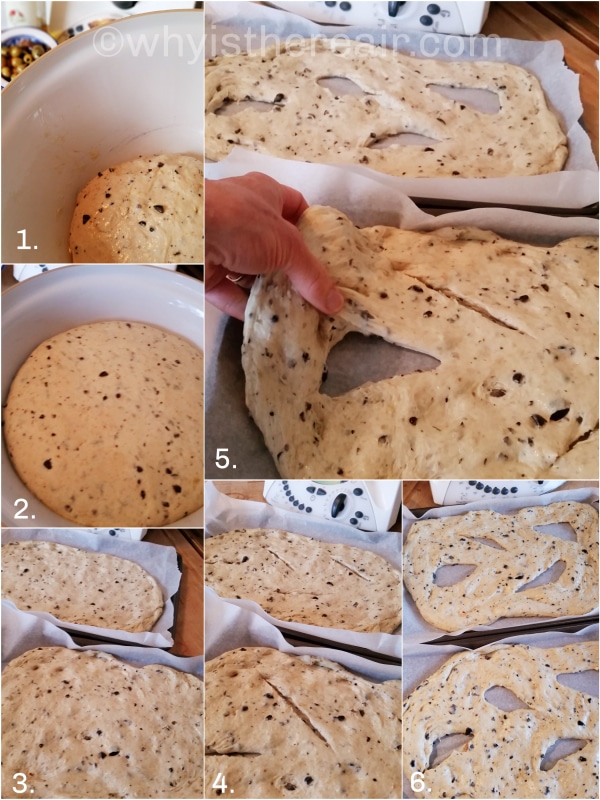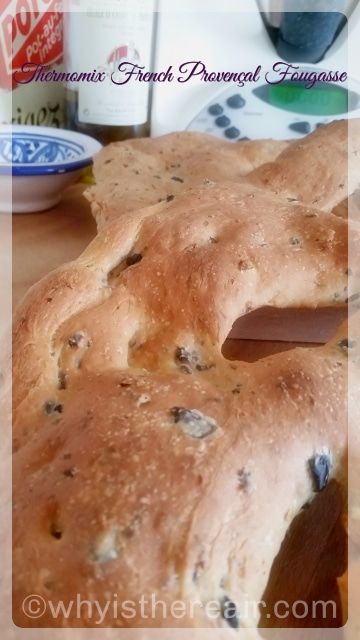French Provençal Fougasse


Think dark, juicy, pungent olives, dripping with oil. Think cicadas chirping in the hot fields of lavender that stretch as far as the eye can see. Think a game of pétanque played by locals in the shade of a graceful plane tree. Think a glass of cool, crisp rosé wine sitting on the table of your favourite café, dappled with sunlight, sitting next to a platter of fougasse, a savoury French Provençal flatbread.
Have I got you there? Can you see it? Can you taste it? I certainly can, but then I really am sitting next to a platter of fougasse that I made in my trusty Thermomix. The only thing missing is the glass of rosé – and that’s only because it’s 8:30 in the morning. You just wait until this evening, and that bottle of rosé will be a delicious but fading memory…
Fougasse
This specialty bread from the south of France is delightful served with a glass of wine or cocktails, at a picnic, and as the bread to accompany a meal with Provençal or Italian flavours. The recipe itself is a tried and tested one from Thermomix France’s bread cookbook, “Mille et une pates… à pain.” I like it with a big plate of salad, antipasti, or crudités. It’s especially good dipped in the best EVOO you can find. This version calls for black and green olives and bacon lardons, but you can use almost anything that catches your fancy – or is lurking in the back of your refrigerator 😉 I had no lardons so I substituted some Parma ham. Pancetta would be lovely, as would sun-dried tomatoes, herbes de provence, small chunks of Parmesan, anchovies, onions, etc. Use your imagination and let Thermomix take you to new heights of cooking!
Ingredients
10 g fresh yeast
300 g semi-skimmed milk
100 g wholemeal flour
400 g plain flour (no need to use bread flour)
40 g olive oil
½ tsp. sea salt
70 g pitted black olives
70 g pitted green olives
100 g bacon lardons or Pancetta cubes
1 tsp. olive oil, to glaze

Method
- Activate the yeast by putting it in the TM bowl with the milk and warming 2 minutes/37° C/Speed 2.
- Add both types of flour, the olive oil, salt, olives and lardons. Close and lock the lid and Knead 2 ½ minutes. Your dough should be stretchy and soft, a bit moister than a typical bread dough.
- Turn the dough out into an oiled bowl, cover it with cling film and let rise in a warm, draft-free place (like in the oven at 50° C) for one hour or until doubled in size.
- Knock back the dough and using your hands or a rolling pin, flatten it into a freeform shape about 1.5 cm or a good ½ inch thick. [I did this directly on a lined baking tray, and I made two medium-sized fougasse (on two trays) rather than what would have been one huge one.] Glaze the shapes with olive oil and a pastry brush. Cut slits in the dough and stretch to create holes.
- Pre-heat your oven to 230° C. Put a tray of water in the bottom to create steam which will help your bread rise a little more and bake with a beautiful crust. While the oven is heating, let your fougasse rise again at room temperature about 20 minutes.
- Bake at 230° C for 20 minutes or until the top and the insides of the holes are golden brown. Remove from oven, place on a cooling rack and serve warm or at room temperature.
Madame Thermomix’s Top Tips:
- How old is your yeast? Has it been in the freezer? Check your yeast by giving the warmed milk mixture a quick burst of the Turbo button. If the yeast is fresh, you’ll have a lovely yeasty smell (imagine that!) and you’ll see bubbles on the surface. If you get no bubbles, you may need to add some new yeast to the milk and start again. If you don’t have any more yeast, you may wish to let your dough rise for quite a long time until it doubles in size, or even overnight in the refrigerator.
- A French tip for getting bread and pasta dough out of the bowl: tip the TM bowl over as usual, and before removing the base, give the black knob of the blade a couple of counter-clockwise/anti-clockwise turns with your fingers. You’ll feel the dough detach from the blade before falling out of the bowl and it will be even easier to remove the blade from the dough.
- If you’ve placed a tray of water in the oven to make steam, let it cool before you remove it so that you don’t scald yourself or anyone else in your kitchen.

Want to know more?
According to Wikipedia, Cuisines et Vins de France and a website entirely dedicated to this unusual and versatile bit of baking, fougasse was originally the bread used to test the temperature of the baker’s oven. “Waste not, want not” has been around for centuries, so the bakers stuffed and topped this first batch with whatever delights they had to hand and served the fougasse to their apprentice bakers as a morning snack. And if the word sounds familiar to you, fougasse is to French bread what focaccia is to Italian bread. In Spain they call it fougassa. All from the Latin, meaning “flat bread cooked under the ashes of a fire.”
Bon appétit !
Hi Lee! Thanks so much for reading Why Is There Air and for asking such a good question. Yes, you can use dry yeast in this recipe and I would use one 7g packet of FAST-ACTING yeast – the kind you just sprinkle into your ingredients. (If you use the yeast you have to activate, you will have to wait until it has activated which is fine but it just takes longer.)
Thanks again for your question, you’ve just given me an idea for lunch and now I can’t wait 😉
Happy Thermomix cooking!
Hello, I was wondering if you could use dry yeast for this recipe, and if so, what quantity?